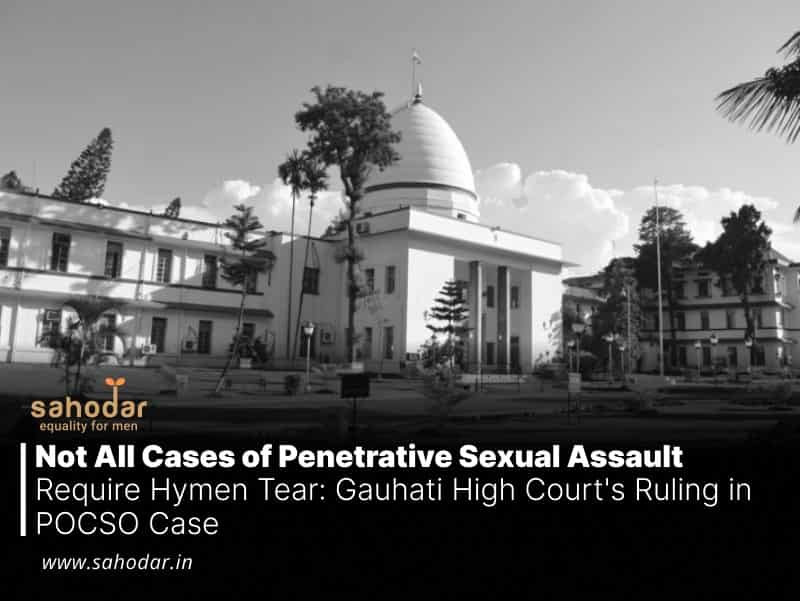“A charge of penetrative sexual assault is made out the moment there is some degree of insertion. Therefore, non-tear of the hymen is of no consequence,” the Court observed.
The Gauhati High Court recently ruled in the case of State of Mizoram v. Lalramliana and Anr, stating that the absence of a hymen tear or lack of genital injuries should not automatically discredit a victim’s claim of penetrative sexual assault.
According to Justice Kaushik Goswami’s explanation, the act of penetrative sexual assault is established once any level of insertion occurs, even if it’s superficial and doesn’t result in visible injuries to the victim’s body.
This observation was made in the context of a case under the Protection of Children from Sexual Offences Act (POCSO Act), where a man was accused of digitally penetrating a 13-year-old girl.
Previously, the accused had been acquitted by a trial court based on a medical officer’s report indicating no genital injuries on the victim, suggesting no evidence of penetrative sexual assault.
The High Court criticized the trial court’s decision as fundamentally flawed, asserting that:
“To bring home the charge of penetrative sexual assault, full penetration of the penis or full insertion of any object or part of the body into the vagina is not required; even part penetration/insertion, which may not necessarily cause injury or bruises to the genitals, is sufficient for the law … in a case where there was superficial digital insertion, a medical examination would not necessarily detect any sign of physical injuries in the genital area of the child. Additionally, superficial digital insertion may not cause a tear of the hymen. Given the above, a charge of penetrative sexual assault is made out of the moment there is some degree of insertion. Therefore, non-tear of the hymen is of no consequence.”
Additionally, the Court noted that it is doubtful for a 13-year-old girl to fabricate claims of sexual assault. Therefore, her testimony can be considered trustworthy and credible, requiring no further corroboration if it appears genuine, plausible, and inspires confidence.
“In a case of sexual assault on a minor girl, what is important to keep in mind is that a minor girl that too of the age of 13 years at the time of occurrence would not ordinarily lie about being sexually assaulted. Therefore, the version of the informant victim has to be considered with utmost care before discerning the same,” the February 29 judgment stated.
The Court was dealing with a case where a 13-year-old reported that she was sexually assaulted by a man in whose house she had been staying for her studies.
The accused man is said to have taken her out with him one evening and groped her before trying to rape her. When she resisted, he is said to have inserted his finger into her vagina before eventually taking her back home.
The victim claimed that she disclosed the incident to her grandmother and the wife of the accused and found no support from either of them. The next day, her teacher saw her crying at school and alerted a district child protection officer.
After the intervention of this officer, a criminal complaint was eventually registered. The girl did not initially mention that the accused had inserted his finger into her body in the first information report (FIR). However, she later disclosed this aspect of the case in subsequent statements to the police and maintained this version of events during the trial.
The High Court observed that it was not natural for the victim to have disclosed the events in such a piecemeal manner, mainly when she did not initially get any support from her grandmother and the wife of the accused, and since she initially had to narrate the events before a male officer. It is only natural that the victim child initially felt uncomfortable in directing disclosing “the act of digital insertion” to her teacher and the male officer, the High Court explained.
The High Court added, “Her statements as regarding the surrounding circumstances have been fully supported by the other witnesses,” concluding that the victim’s testimony inspired confidence.
The High Court set aside the trial court’s decision to acquit the accused by giving him the benefit of the doubt.
However, the High Court did not proceed to convict the accused upon noticing that the trial court had framed charges wrongly.
Instead of framing a charge for aggravated penetrative sexual assault (punishable with a minimum sentence of 20 years in jail) under Section 5 (n) (sexual assault by a relative or a person living in the same shared household) of the POCSO Act, the trial court had cited a charge of penetrative sexual assault under Section 4 (which is punishable with a minimum sentence of 10 years in jail).
Therefore, the High Court remanded the matter back to the trial court.
“The accused/respondent No.1 cannot be convicted under a provision of law prescribing higher punishment without giving him an opportunity … Given the above, I am of the considered view that the matter be remanded back to the Trial Court for re-framing the charge,” the Court said.
Therefore, the accused was ordered to appear before the trial court on April 22, and the trial court was ordered to conclude the trial, preferably within three months thereafter.
These observations allowed the State’s appeal challenging the trial court’s earlier acquittal.
Additional Public Prosecutor Mizoram Linda L Fambawl represented the State government.

